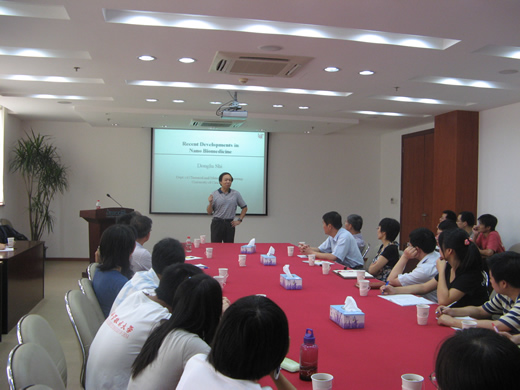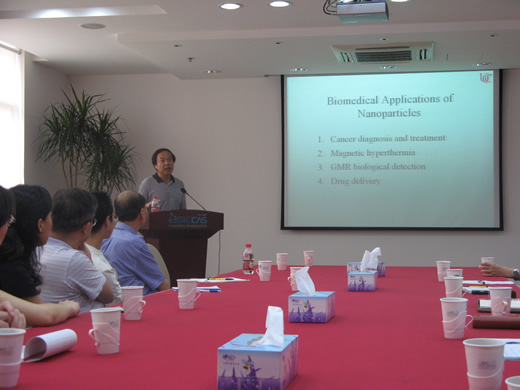On September 12, 2008, at the invitation of Professor Jiang Chang, Prof. Donglu Shi, the full professor at University of Cincinnati, visited SICCAS and given a brilliant academic lecture, titled “Development of Multi Functional Nanostructures for biomedical imaging and treatment”. Prof. Donglu Shi received his M. S. (in Physics) in 1983 and Ph. D. (in Superconductivity) in 1986 from the University of Massachusetts at Amherst. After graduation, he took a Staff Scientist position at the Materials Science Division of Argonne National Laboratory in 1987 (first year as a posdoc). At Argonne, he was a principle investigator for a major Department of Energy program on High-Tc superconductors. In the fall of 1995, Donglu Shi joined the faculty as an Associate Professor in the Department of Materials Science and Engineering at University of Cincinnati. He was promoted to the full professor position in 2001 at University of Cincinnati. Donglu Shi has so far published 200 refereed journal publications including Physical Review Letters, Nature, and Advanced Materials. He has edited six books in superconductivity, functional thin films, nanomaterials, biomaterials, and tissue engineering.
In cancer diagnosis and therapy, be able to locally biomark the cancer cells in clinical pathology for maximum therapeutic benefit, targeting and localized treatment are all the key challenges. Now, Prof. Donglu Shi’s lecture gave us one promising strategy for overcoming these challenges by designing fluorescent nanoparticles and nanostructure for qualitative or quantitative in vivo detection of tumor cells. By novel surface engineering, multiple functionalities are developed in a nano assembly for both in vivo imaging and treatment. Such a nano assembly possesses several uniquely combined functionalities including strong fluorescence, anti cancer drug storage, and hyperthermia. In this way, it is possible that early cancer diagnosis and local treatment can be achieved simultaneously.
The new and unique views of the lecture have aroused great interest of everyone, and they gave a warm applause when the lecture ended. In view of its original perspectives, the lecture will surely provide a guideline for the future development of biomaterials and nanomaterials, and give inspirations to research staff in SICCAS.






